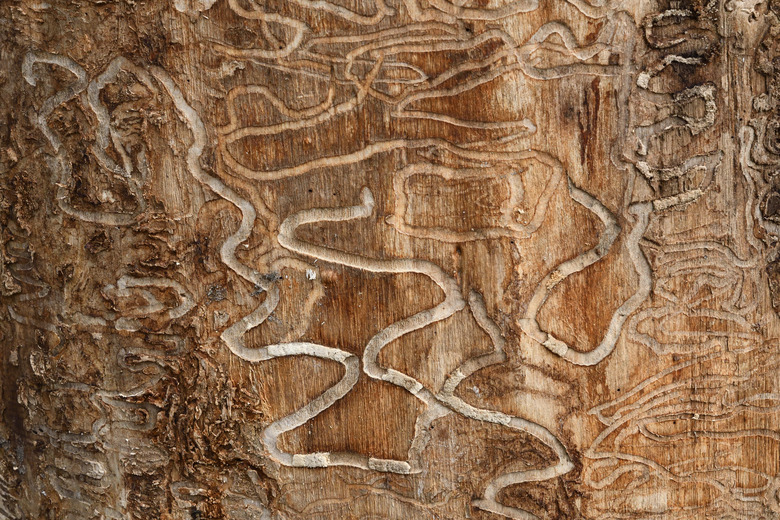How To Kill Tree Borers
Tree borers are the larvae of beetles and moths that tunnel underneath bark to feed on living wood, weakening and sometimes killing valuable shade trees and ornamental trees. Depending on the type of insect, you could find signs of damage such as holes drilled along the trunk and branches, sawdust-like frass, oozing, cracks, cankers, or dieback of the plant. Many wood-boring insects attack trees that are already under stress from drought, injury, or disease. Take preventive action against borers by keeping your trees in good health and regularly inspecting them to detect early signs of damage.
If an infestation has occurred, use the recommended pesticide to kill the borers, making sure to spray when the insects are most vulnerable to insecticide. Wood-boring insects tend to attack and be named for specific tree species, which makes it easier to determine what kind of insect is attacking your tree.
Tip
As a preventive measure, avoid injuring the roots and trunks of trees. Such injuries serve as entry points for the borers. Using tree species that are adapted to your local growing area keeps trees healthy and less prone to diseases and pests. It's best to remove seriously infested trees as these cannot be saved.
Types of Tree-Boring Insects
Types of Tree-Boring Insects
There are two main types of tree-boring insects: the larvae of clearwing moths and the larvae of flatheaded beetles. Clearwing borers include banded ash, dogwood, lilac, peachtree, and rhododendron borers. Peachtree borers will attack peach trees, of course, as well as plums and cherries. The adult clearwing moths look much like small wasps. Though you aren't likely to see them, their caterpillars are hairless and whitish with brown heads.
Flatheaded borers include the emerald ash, bronze birch, and flatheaded appletree borers. The adult beetles are flat, long, and metallic. The larvae look like whitish, segmented grubs. Flatheaded appletree borers attack apple trees, crab apples, pears, hawthorns, and a wide range of large shade trees such as poplars, oaks, and sycamores. Flatheaded borers make D-shaped holes in the bark when they emerge as adults.
Spraying for Clearwing Tree Borers
Spraying for Clearwing Tree Borers
Regardless of the type of borer attacking your trees, in order to be effective, you'll need to spray just as fully adult moths or beetles are emerging from beneath the bark. Timing varies depending on your climate and the insect species, so check with your local extension office for the best time to spray. Also remove and throw out any dead, infested branches before the adults emerge to reduce the population.
For clearwing borers, pyrethroids such as bifenthrin and permethrin are effective. Fruit trees are best protected by spraying preventively on the trunk and main limbs before an infestation occurs.
Spraying for Flatheaded Borers
Spraying for Flatheaded Borers
For infested birch trees, spray bark with an insecticide containing permethrin or bifenthrin during the time period recommended for your climate. For appletree borers, spray the trunk and larger branches when adult beetles first emerge, shortly after bloom, and then every three weeks while adults are present on the trunk, using insecticides containing phosmet or carbaryl. Both types of infestations can also be treated with a soil drench containing imidacloprid.
Because the emerald ash borer has devastated trees across North America, many advise against ever planting an ash tree on your property. If you do own an ash tree, spray the trunk with permethrin, bifenthrin, cyfluthrin, or carbaryl as a preventive measure. Infested trees can be treated with a soil drench containing imidacloprid or dinotefuran or by injecting the trunk with an insecticide. If more than half the canopy has been killed, the tree is unlikely to survive and should be removed.
Tip
Make sure to check which pesticides are legal for homeowners to apply in your state, always follow the instructions on the label, and consider checking with an arborist for professional advice.
